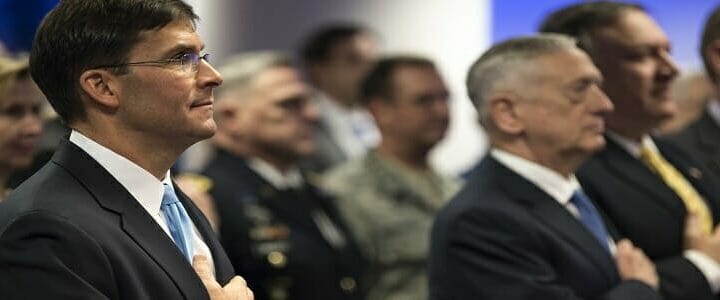The annual meeting of the Association of the United States Army (AUSA) – the yearly meeting of the military, industry, academia, and government – kicked-off Monday morning at the Washington Convention Center. In keeping with tradition, Secretary of the Army Mark T. Esper delivered the keynote address, in which he described his vision for the Army’s future direction.
The AUSA annual meeting, in Esper’s words, “allows us to have a candid, professional discussion about what’s best for the Army.” He used his keynote to address four main themes: readiness and lethality, modernization, doctrine, and reform. These efforts, he said, amount to “nothing short of an Army renaissance” that represents “a renewal in how the Army envisions and prepares for future conflict.”
Readiness & Lethality
Esper described an Army that is “ready today and even more lethal tomorrow.” He said the Army is “investing heavily” to make that happen. Most significantly, he announced that to build a more lethal force, the Army is extending initial entry training for some soldiers. Earlier in the year, the Army expanded the infantry’s “One Station Unit Training” (the combination of Basic Training and Advanced Individual Training) by two months. Esper claimed this makes Infantry One Station Unit Training “the longest and hardest in the world.”
That expanded training, deigned to ensure that new soldiers are ready to deploy with heir units as soon as they’re done with training, will soon expand to the armor and engineer branches. The Army will soon look to expand initial entry training for other branches as well, the secretary promised.
Modernization
There has been a lot of talk about the Army’s six modernization priorities: the next generation combat vehicle, long-range precision fires, future vertical lift, the Army network, soldier lethality, and air and missile defense capabilities. Esper expanded on all of these in his address.
In an effort “to guarantee overmatch for years to come,” the secretary said that “in the next few years,” the Army will unveil prototypes of the the next generation combat vehicle, the squad automatic weapon, a mobile short-range air defense system, and a strategic long-range cannon. To help spur the innovation necessary to realize those modernization goals, Esper pointed to the fact that a year ago, the Army Futures Command was “just an idea,” and now its headquarters are up and running in Austin, TX.
Esper issued a call to industry to “invest in us” by bringing the Army “the ideas and innovative solutions that will modernize the Army.” He emphasized, “Our six priorities are clear, and they will not change,” promising that the Army is “moving away from lengthy requirements documents and long processes.”
Doctrine
Calling doctrine a “critical component” of the Army renaissance, Esper hinted that Muti-Domain Operations(MDO), unveiled last year as a new concept (original called Multi-Domain Battle), might soon become the official Army war fighting doctrine.
He told the audience that “the importance of space and cyber domains has rendered the AirLand Battle doctrine inadequate, if not obsolete.” All of the war fighting domains have become “too interconnected to fight each in isolation.” for that reason, Esper said the Army would soon release “the next evolution of Multi-Domain Operations doctrine which describes how the Army fights in all domains as part of the point force.”
Doctrine is more formal and institutionalized than concepts. By calling MDO a “doctrine” Esper signaled the way ahead. To fight across these new domains, corps headquarters will soon be reinforced with electronic warfare companies, and brigade combat teams will gain cyber and electronic warfare teams.
Reform
“Reform” Esper said, “is not an end unto itself, but rather the means by which we take control of our own destiny.”
In that vein, he has been quietly working for the last several months to reform the Department of the Army, and looking long and hard at each of the programs in the budget. Last year, Ryan McCarthy, the under secretary of the Army, led a comprehensive review of the Army’s science and technology portfolio to focus future spending on the modernization priorities. Recently, Esper has been doing the same thing in each of the programming execution groups, called PEGs inside the Pentagon.
While there hasn’t been a lot of discussion of this “night court” effort outside the Pentagon, Esper claimed that his intense PEG reviews so far have “freed-up over $25 Billion, and countless personnel billets, that we will put back into building readiness and modernizing the Army.” Expect to hear more in the new future about further structural reforms in the Army’s headquarters as Esper looks to shift decisions from the Pentagon to the field.
The AUSA gathering continues through Wednesday. Chief of Staff Gen. Mark Milley will speak during lunch on Tuesday afternoon. Speeches and panel discussions are available as a live stream and video archive at https://www.ausa.org/events/2018-annual-meeting/live-stream.



